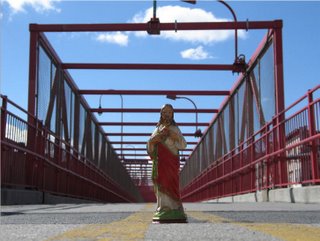The Hindu Holy TrinityWithin the Hindu trinity of Brahma, Vishnu and Shiva, Brahma is the creator, Vishnu the preserver and Shiva the destroyer.
Brahma grew in a lotus out of the navel of the sleeping Vishnu. This means the creator grew out of the preserver. A contradiction, I know, but what can you do? The daily alternation of light and dark is attributed to the activity of Brahma, which reminds me: tomorrow is daylight savings time. Don’t forget to turn your clocks ahead one hour.
In order to create the world and produce the human race, Brahma made a goddess out of himself. One half was woman and the other half was man. Brahma called the woman Gayatri, but she also became known by many other names such as Saraswati.
Vishnu is the preserver and protector of creation. Vishnu is the embodiment of mercy and goodness, the self-existent, all-pervading power that preserves the universe and maintains the cosmic order Dharma (rules of existence, the basic “is” of what is).
Vishnu is often represented resting on the coiled serpent Shesha, with Vishnu's consort Lakshmi massaging his feet (aaaaah!). Vishnu never sleeps (ew!) and is the deity of Shanti, the peaceful mood. Vishnu does not however tolerate Ego.
Shiva is the destroyer of the world, after which Brahma again creates the world and so on. Shiva is responsible for change both in the form of death and destruction and in the positive sense of the shedding of old habits. Shiva is the god of the yogis, self-controlled and celibate, while at the same time a lover of his spouse. Another contradiction, yes, but I am happy for Mrs. Shiva. Shiva lives on Mount Kailasa in the Himalayas. The vehicle of Shiva is the white bull called Nandi (the joyful). He is often seated on a tiger skin or wears a tiger skin, with the tiger representing the mind.
Shiva’s dance represents both the destruction and the creation of the universe and reveals the cycles of death, birth and rebirth. His Dance of Bliss is for the welfare of the world. Under his feet, Shiva crushes the demon of ignorance called Apasmara Purusha, caused by forgetfulness. One hand is stretched across his chest and points towards the uplifted foot, indicating the release from earthly bondage of the devotee. The fire represents the final destruction of creation, but the dance of the Nataraj is also an act of creation, which arouses dormant energies and scatters the ashes of the universe in a pattern that will be the design of the ensuing creation. I like the idea of the apocalypse as a form of dance rather than plagues and demons tormenting people. This doesn’t mean I necessarily want to see such a dance, however.













